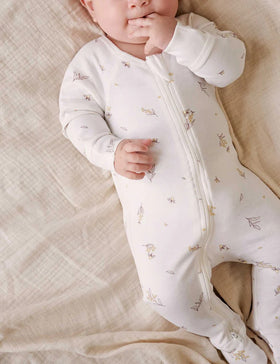How do I choose between sizes, shield types and nipple shapes?
Every baby is different, and Natursutten’s nipples come in several varieties to best fit your baby’s needs and preferences.
All Natursutten® pacifiers are available in three guiding sizes:
S (0-6 months), M (6-12 months) and L (12 months and above).
The age ranges are guides only. Some babies prefer a larger and some a smaller nipple.
The shield touches my baby’s nose! Why?
The relatively large shield on Natursutten® Original is designed to gently touch your baby’s nose and give her the same secure feeling she experiences during breastfeeding. For those who prefer another shape, you can try the Natursutten® Butterfly pacifier. This model leaves room for your baby's nose.
How do I treat the pacifier?
Before the first use, just sterilize by immersing the pacifier in boiling water for five minutes. Make sure the pacifier doesn’t touch the bottom of the pot. Afterwards, just clean on a daily basis, by washing it in mild liquid soap under running water — if it needs an extra thorough clean place it in a strainer and sterilize it by pouring boiling water over it. But don’t boil it again and never leave it to cool down in boiling water. Because the pacifiers are made from natural rubber, they are not dishwasher-safe. And we don’t recommend the use of sterilizers.
What is the lifespan of a Natursutten pacifier?
Natursutten® must be replaced every 6 – 8 weeks. It’s important to inspect the pacifier carefully before each use and throw away at the first signs of damage or weakness. The pacifier will get darker and somewhat sticky if you use it for too long. Should the pacifier shows signs of deterioration (peeling) it must be replaced immediately.
My baby has a latex allergy. Can she use the Natursutten pacifier?
Yes, and no. The protein that on rare occasions can provoke a latex allergy is removed from the rubber sap used for Natursutten® pacifiers. This means that there is no risk of provoking a latex allergy when using them. That said, we would never recommend using a product made from natural rubber for a child with a diagnosed latex allergy.
My pacifier has a ‘whitish’ layer. What is that?
When caring for your Natursutten® pacifier it’s important to remove it from the boiling water after initial sterilising. And not to boil it again!
The ‘whitish’ layer on the surface is scale from your water that attach to the pacifier. It’s harmless but makes the pacifier look dull. It will disappear again after a few washes under running water and with the use of a mild liquid soap.
What is the right color for a new Natursutten pacifier?
A Natursutten® pacifier is made from organic material and as such it will look different from harvest to harvest. Just like no to apples are never identical. Sometimes they are light yellow, sometimes dark amber. Sometimes transparent and sometimes more milky. It’s all perfectly normal and intended. No chemicals are added to make them look the same.
Why does my pacifier get darker with use?
A Natursutten® pacifier will get darker over time, because its 100% natural rubber contains no chemicals or anti-oxidants to keep it light orange. This is perfectly natural and to be expected.
I have been leaving our pacifier in boiling water to cool – what effect does this have?
The only thing that happens, if you leave the pacifier to cool down in the boiling water is that scale from your water will attach to the pacifier and making it look dull. It’s harmless and it will disappear again, but it looks dull. Another thing; don’t boil the pacifier again after initial sterilising. It will age and become sticky too quickly if you do. In daily care just wash it under running water and use a mild liquid soap. If it needs an extra thorough rinse place it in a strainer and pour boiling water over it.
Is it safe?
All Natursutten® pacifiers are EN 1400-certified, which means the product complies with the European Union (EU) directive for this product area—in terms of safety, health and environment. They are continuously tested by ConsumerLab, an independent, distinguished laboratory in Denmark. The products are also tested in the U.S. and comply with all standards established by the CPSIA. In Australia where they comply with australian and New Zealand standards, and towards strict Japanese standards too.








